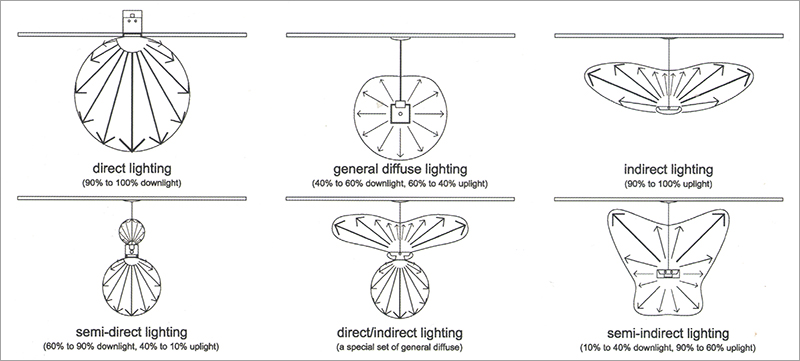What Is Direct and Indirect Lighting?
The aim of a lighting designer is always to create comfortable, healthy, and beautiful spaces for its users. In the design process, the designer takes advantage of the direct and indirect lighting systems and creates various ambiances by considering the functional and psychological needs.

The aim of a lighting designer is always to create comfortable, healthy, and beautiful spaces for its users. In the design process, the designer takes advantage of the direct and indirect lighting systems and creates various ambiances by considering the functional and psychological needs.
The chosen lighting system type can enhance the value and the comfort of an area, and vice versa. From the very first stage of the design, the designer should choose the lighting system according to the environment he/she wants to create and consider lighting standards, energy-saving requirements, and user comfort at the decision stage.
Types of lighting distribution
There are six different types;
Direct lighting, 90% to 100% downlight, light falls from the luminaires on the ceiling directly onto the working place, anti-glare is important, the ceiling may look dark (cave effect), high energy-efficiency, downlights are samples for direct lighting.
General diffuse lighting, 40% to 60% downlight, 60% to 40% uplight, the light since it passes through the glass or plastic, like some globes.
Indirect lighting, 90% to 100% uplight, light directed to the ceiling or walls illuminate workplaces indirectly, glare-free, low energy-efficient.
Semi-direct lighting, 60% to 90% downlight, 40% to 10% uplight.
Direct/indirect lighting, light falls directly or indirectly via the ceiling, energy-efficient.
Semi-indirect lighting, 10% to 40% downlight, 90% to 60% uplight.
When and where, which lighting system?
The primary elements that determine the decisions taken in lighting design are the architectural features and the function of the space. The types of used materials, colors, textures, and reflection coefficients, physical characteristics like the height of an environment play a decisive role in the designer’s decisions.
It is necessary to have direct lighting in workplaces such as offices, commercial and industrial establishments, hospitals, showrooms, in terms of occupational safety, employee performance, and comfort. With the right light beam angles and proper spacing, the lighting fixtures with direct light distribution can provide balanced general illumination, or accent lighting by directing the light to an object or a surface. The lumination of a statue or a painting in exhibition areas is accent lighting.
Glare in is an issue to consider. For example, lighting fixtures with UGR <19 should be in the work areas.
Indirect light also can be used as general or ambient lighting. Cove lighting is an example of indirect ambient lighting. The crucial issue in indirect lighting systems is energy-efficiency. Since the light source is hidden and light is reflected via ceiling or walls, to provide a high lighting level, it can cause to use high lumen output light sources. On the other hand, indirect light does not create uncomfortable shadows and glare and provides a pleasant ambiance.
Combination of direct and indirect lighting
Only direct lighting can be more practical but may create a sharp contrast between light and shadows and also cave effect. Only indirect lighting will illuminate the walls and ceiling, but it is possible to have insufficient lighting levels for some tasks.
The well-balanced combination of indirect and direct light sources allows us to achieve energy-saving lighting systems and lively, attractive, comfortable environments.
Sources:
https://www.architectmagazine.com/technology/lighting
https://www.zumtobel.com/
https://www.researchgate.net/figure/Examples-of-direct-and-indirect-lighting
https://www.lightingassociates.org/i/u/2127806/f/tech_sheets/Lighting_with_Artifical_Light.pdf
https://www.energineo-led.com/difference-entre-eclairage-direct-et-indirect/






